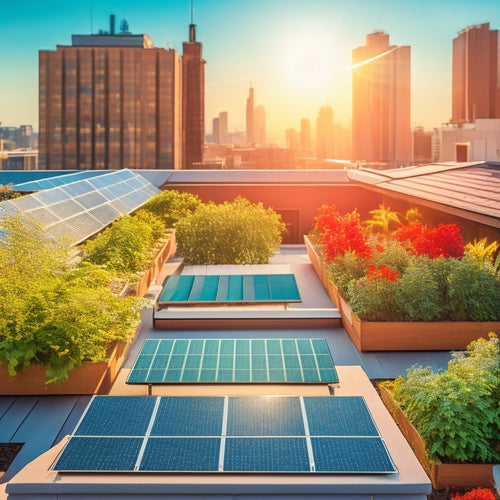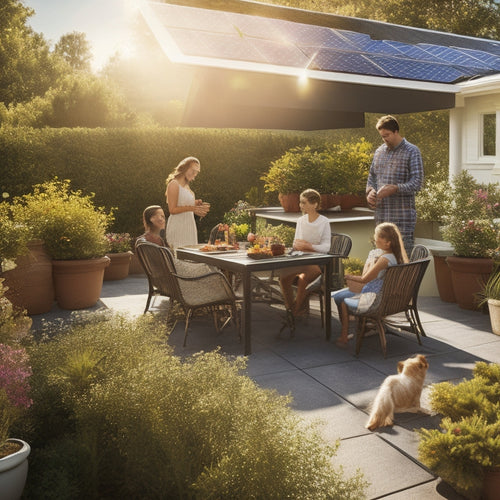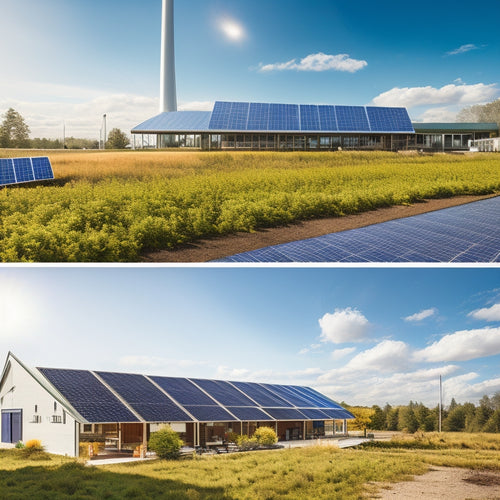
Create an Effective Home Solar System in 10 Simple Steps
Share
You'll need to assess your energy needs by gathering past electricity bills and evaluating home efficiency to identify areas of energy waste. Next, choose the right solar panels by considering panel efficiency, durability, and cost, and select a compatible inverter to convert DC power to AC. Plan your system layout by maximizing panel orientation and configuration, and verify proper installation with secure electrical connections and high-quality mounting hardware. Monitor system performance, consider energy storage options, research incentives and rebates, and perform regular maintenance to guarantee peak system performance. By following these 10 simple steps, you'll be well on your way to creating an effective home solar system that meets your unique energy needs, and there's more to investigate to get the most out of your investment.
Key Takeaways
- Assess energy needs by gathering past electricity bills and evaluating home efficiency to determine the required solar system size.
- Choose the right solar panels based on efficiency, durability, and cost, considering factors like tempered glass and weather-resistant coatings.
- Select a compatible inverter that efficiently converts DC power to AC power, ensuring compatibility with the solar panel system's voltage and power output.
- Optimize system layout by considering panel orientation, shading analysis, and roof size to maximize energy production and overall system efficiency.
- Monitor system performance in real-time to ensure the system meets energy needs and identify areas for improvement.
Assess Your Energy Needs
Get started by sizing up your energy appetite. Understanding your energy consumption is essential in determining the right solar system for your home.
Begin by gathering your past electricity bills to calculate your average daily energy usage in kilowatt-hours (kWh). You can also use online tools to estimate your energy consumption based on your home's size, location, and appliances.
Next, evaluate your home's efficiency. Identify areas where energy is being wasted, such as inefficient lighting, outdated appliances, or poor insulation.
Implementing energy-saving measures like LED bulbs, Energy Star appliances, and sealing air leaks can greatly reduce your energy consumption. This, in turn, will allow you to install a smaller, more cost-effective solar system.
Accurately evaluating your energy needs will help you design a solar system that meets your specific requirements.
Choose the Right Panels
With your energy needs assessed, you're ready to select the perfect solar panels for your home. This involves evaluating panel efficiency, which refers to the amount of sunlight that's converted into electrical energy. Higher efficiency panels produce more power per unit area, making them ideal for smaller roofs or areas with limited space. However, they're often more expensive.
When choosing solar panels, consider panel durability as well. Look for panels with a durable frame, tempered glass, and a weather-resistant coating to guarantee they withstand harsh weather conditions. A durable panel will last longer, reducing the need for frequent replacements and minimizing maintenance costs.
Additionally, consider the type of solar panel: monocrystalline, polycrystalline, or thin-film. Monocrystalline panels are the most efficient but also the most expensive. Polycrystalline panels offer a balance between efficiency and cost, while thin-film panels are the most budget-friendly option.
Select a Compatible Inverter
You've selected your solar panels, now it's time to confirm you have a compatible inverter to convert the DC power they produce into AC power for your home. The inverter is an essential component of your solar system, as it guarantees the energy generated is usable and safe for your home.
There are three main inverter types: string inverters, microinverters, and power optimizers. String inverters are the most common and cost-effective option, while microinverters provide more flexibility and monitoring capabilities. Power optimizers offer a balance between the two.
When selecting an inverter, consider its efficiency ratings. Look for inverters with high efficiency ratings, typically above 95%, to minimize energy loss during conversion.
Additionally, confirm the inverter is compatible with your solar panel system's voltage and power output. A compatible inverter will guarantee maximum energy production and a safe, reliable connection to your home's electrical system.
Plan Your System Layout
Plan Your System Layout
Your solar panel system's layout is essential to its performance and longevity. A well-planned layout guarantees maximum energy production, reduces potential shading issues, and facilitates maintenance. To plan your system layout, consider the following factors:
| Factor | Description | Considerations |
|---|---|---|
| Solar Panel Orientation | The direction and angle of your solar panels | Optimize for your location's latitude and seasonal variations |
| Site Shading Analysis | Identify potential shading sources (trees, buildings, etc.) | Guarantee minimal shading, especially during peak sun hours |
| Panel Configuration | The arrangement of solar panels in rows and columns | Balance energy production with space constraints |
Consider your roof's size, shape, and orientation when determining the ideal solar panel placement. A south-facing roof with minimal shading is ideal, but an east- or west-facing roof can still be effective. Use online tools or consult with a solar expert to determine the best layout for your system. By carefully planning your system layout, you'll maximize your energy production and enjoy a reliable, long-lasting solar panel system.
Ensure Proper Installation
Proper installation is vital to getting the most out of your solar panel system. A poorly installed system can lead to reduced energy output, safety hazards, and even void your warranty.
To avoid these issues, it's important to follow installation guidelines and consider hiring professional services.
When installing your solar panel system, make certain to:
- Conduct a thorough site assessment to identify potential shading issues
- Verify all electrical connections are secure and meet local building codes
- Use high-quality mounting hardware and flashing to prevent water damage
- Install a monitoring system to track your energy production
- Perform routine maintenance checks to identify potential issues before they become major problems
Maximize Roof Space Usage
Optimizing roof space is crucial when installing a solar panel system, as it directly impacts energy production and overall system efficiency. You want to guarantee that your solar panels are installed in a way that maximizes their energy output.
To do this, you'll need to take into account your roof's orientation and perform a shading analysis. This analysis will help you identify areas of your roof that receive the most sunlight and are least affected by shading from trees, buildings, or other obstructions.
Here's a breakdown of how roof orientation affects energy production:
| Roof Orientation | Energy Production |
|---|---|
| South-facing | Highest |
| West-facing | Moderate |
| East-facing | Moderate |
| North-facing | Lowest |
Additionally, take into account the following factors to maximize your roof space:
- Avoid installing panels in areas with heavy shading
- Use a solar panel layout that accommodates your roof's unique dimensions and obstacles
- Think about using microinverters or power optimizers to mitigate the effects of shading on individual panels
Monitor System Performance
You've carefully optimized your roof space to maximize energy production, now it's time to verify your system is running at its best.
System monitoring and performance tracking are essential to guarantee your solar panel system operates efficiently and effectively. By keeping a close eye on your system's performance, you can identify potential issues before they become major problems.
Here are the key components to focus on when monitoring your system's performance:
-
Real-time energy production monitoring: Track your system's energy output in real-time to verify it's meeting your energy needs.
-
Energy usage monitoring: Monitor your energy consumption to identify areas for improvement and enhance your energy usage.
-
System alerts and notifications: Set up alerts to notify you of any system malfunctions or performance issues.
-
Performance benchmarking: Compare your system's performance to industry benchmarks to verify it's operating at peak levels.
-
Data analytics and reporting: Use data analytics and reporting to identify trends and patterns in your energy production and consumption.
Consider Energy Storage Options
You'll want to evaluate energy storage options to guarantee a steady power supply during outages or when the sun isn't shining.
Battery backup systems are a popular choice, providing a reliable source of energy when you need it most.
Additionally, solar power banks offer a portable and convenient way to store excess energy generated by your solar panels.
Battery Backup Systems
With renewable energy sources like solar power becoming increasingly prevalent, homeowners are looking for ways to guarantee a steady supply of electricity, even during periods of low sunlight or power outages.
A battery backup system is a reliable solution, providing a steady flow of energy when you need it most.
When selecting a battery backup system, you'll need to evaluate the type of battery that best suits your needs. You have three primary options:
- Lead-Acid Batteries: Affordable and widely available, but heavy and less efficient.
- Lithium-Ion Batteries: Lighter, more efficient, and longer-lasting, but more expensive.
- Sodium-Ion Batteries: A newer, more cost-effective alternative to lithium-ion batteries.
- Flow Batteries: Ideal for long-duration energy storage, but larger and more complex.
- Nickel-Cadmium Batteries: A reliable, maintenance-free option, but more expensive and toxic.
When installing your battery backup system, remember to follow proper installation tips, such as placing batteries in a well-ventilated area, away from flammable materials, and ensuring correct wiring and connections.
Solar Power Banks
In addition to battery backup systems, solar power banks offer another energy storage option for homeowners seeking a reliable and portable power solution. These devices store excess energy generated by your solar panels during the day, allowing you to use it whenever you need it. Solar power banks come in various types, including portable chargers and capacity-specific models.
| Feature | Description |
|---|---|
| Solar Bank Types | Portable chargers, capacity-specific models (e.g., 500Wh, 1000Wh) |
| Capacity Ratings | Measured in Wh (watt-hours), determines how much energy can be stored |
| Charging Speeds | Varying speeds, from slow trickle charging to rapid charging |
| Usage Scenarios | Camping, outdoor events, power outages, daily device charging |
| Environmental Impact | Reduces reliance on fossil fuels, minimizes e-waste |
When considering solar power banks, evaluate your energy needs and choose a model that suits your usage scenario. Research brand comparisons and cost analysis to find the best value for your investment. Remember to also consider the environmental impact of your choice, as solar power banks can greatly reduce your carbon footprint.
Research Incentives and Rebates
You'll want to research the incentives and rebates available to you, as they can greatly offset the cost of your home solar system.
The federal government offers tax credits that can be claimed on your income taxes, and you may also be eligible for state and local rebates or incentives.
Federal Tax Credits
Over 25% of the total cost of your home solar system can be offset by federal tax credits, making them a considerable incentive for homeowners investing in renewable energy.
As you consider installing a solar panel system, understanding federal tax credits can help you maximize your savings.
To qualify for the federal tax credit, you'll need to meet certain eligibility criteria. Here are the key points to keep in mind:
- You must have a taxable income to qualify for the credit
- The solar panel system must be installed on your primary or secondary residence
- The system must be installed between 2006 and 2023
- You must own the solar panel system (leasing doesn't qualify)
- You must file for the credit in the same tax year as the installation
When filing for the credit, you'll need to complete Form 5695 and attach it to your tax return.
Be sure to keep detailed records of your installation costs and system specifications to accurately claim the credit.
State and Local
Beyond federal tax credits, state and local governments offer various incentives and rebates to motivate homeowners to adopt solar energy.
You'll want to investigate the specific programs available in your area, as they can greatly influence the overall cost of your solar system. Start by reviewing your state's regulations, which may include rebates, tax credits, or exemptions.
You may also find local incentives, such as property tax exemptions or special financing options. Additionally, community programs, like community solar gardens or energy cooperatives, can provide access to solar energy even if you can't install panels on your own property.
Before installing your system, verify you have the necessary installation permits and comply with local zoning laws.
You may also want to examine utility partnerships, which can provide additional incentives or special rates for solar customers. Some states and local governments offer solar financing options, such as low-interest loans or property-assessed clean energy (PACE) financing.
Perform Regular Maintenance
Get into the habit of checking your home solar system regularly to confirm it's running at peak performance.
Regular maintenance guarantees your system operates efficiently, maximizes energy production, and reduces the risk of safety hazards.
To keep your system in top shape, focus on the following key areas:
-
System cleaning: Remove dirt, debris, and other obstructions that can reduce energy output.
-
Panel inspection: Check for signs of damage, cracks, or wear, and replace panels as needed.
-
Inverter maintenance: Verify the inverter is functioning correctly, and update its software or firmware as necessary.
-
Wiring checks: Inspect wiring for signs of wear, corrosion, or damage, and repair or replace as needed.
-
Performance evaluations: Monitor your system's energy production and compare it to its expected output, identifying areas for improvement.
Frequently Asked Questions
Can I Install Solar Panels on a Metal or Clay Tile Roof?
You can install solar panels on a metal roof with specialized metal roof installation equipment, while clay tile considerations require careful planning to avoid damaging the tiles, ensuring a secure and watertight seal.
How Do I Protect My Solar System From Wildlife Damage?
Like a vigilant guard, you're wise to shield your solar system from wildlife damage. You'll want to install wildlife barriers and protective netting around your panels to prevent curious critters from chewing through wires or nesting underneath.
Are Solar Panels Resistant to Hail and Extreme Weather?
You'll be relieved to know that solar panels are designed to withstand hail damage and extreme weather conditions, with most manufacturers testing their products to resist impacts from 1-inch hailstones traveling at 50 mph.
Can I Add More Solar Panels to My Existing System Later?
You can add more solar panels to your existing system later, but you'll need to guarantee system compatibility and consider solar panel expansion limitations, such as available roof space and inverter capacity, to maximize energy output.
Do Solar Panels Work Well in Areas With Frequent Fog or Shade?
You'll find that solar panels still work in areas with frequent fog or shade, but their solar efficiency takes a hit. The fog impact reduces energy output, so you'll need to take into account this when sizing your system to meet your power needs.
Conclusion
You've successfully created an effective home solar system in 10 simple steps. Now, you're utilizing free energy from the sun and reducing your reliance on the grid. Did you know that, according to the National Renewable Energy Laboratory, a typical residential solar system can save homeowners between $400 and $1,000 per year on their electricity bills? With your new system, you'll be enjoying those savings for years to come, while also contributing to a cleaner, more sustainable future.
Related Posts
-

Solar System Installation Rebates and Tax Credits
Solar system installations offer beneficial rebates and tax credits that greatly cut your initial costs. You can bene...
-

Long-Term Cost Savings With Solar Panels
Investing in solar panels offers substantial long-term savings on energy costs. You'll benefit from federal tax credi...
-

Off-Grid Solar Solutions for Eco-Conscious Businesses
Off-grid solar solutions offer you a path to both sustainability and substantial cost savings. By adopting these syst...


